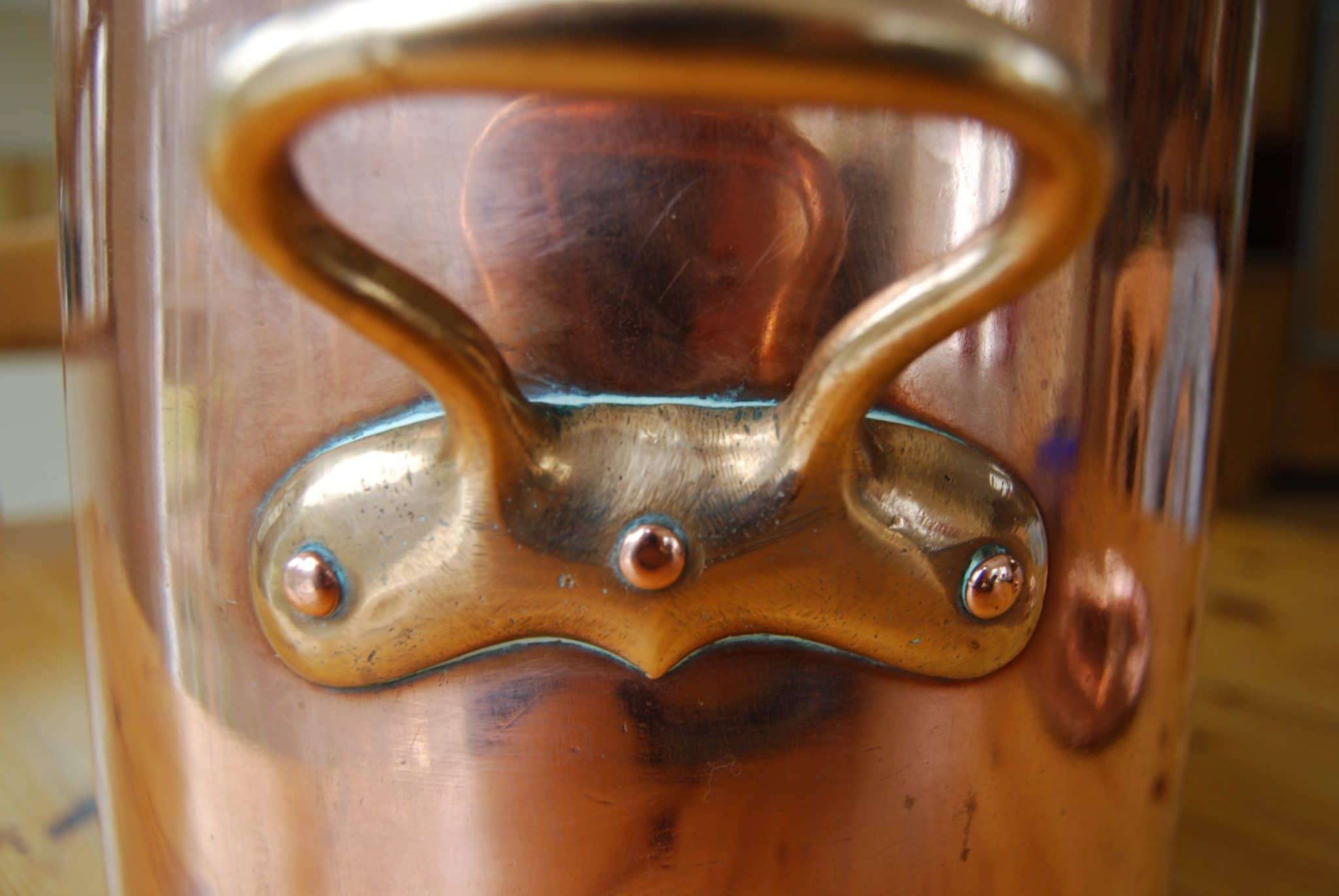Seeing these two together reminds me of an old Grace Jones song: I’m not perfect, but I’m perfect for you.

| Type | Tin-lined collared cul-de-poule with brass stick handle fastened with two copper rivets | Tin-lined soup pot in hammered finish with brass handles fastened with three copper rivets; fitted lid with brass handle fastened with two copper rivets on each bracket |
| French description | Cul-de-poule étamé, avec col, avec queue de laiton munie de deux rivets en cuivre | Bain à potage étamé et martelé avec poignées en laiton munies de trois rivets en cuivre; couvercle emboîté avec poignée en laiton muni de deux rivets en cuivre sur chaque support |
| Dimensions | 22cm diameter by 19cm tall (8.5 inches by 7.5 inches) | 22cm diameter by 23cm tall (8.5 inches by 9 inches) |
| Thickness | 1mm thickness at collar, but the body feels thicker, so the collar may be a separate piece | 1.9mm at rim |
| Weight | 1650g (3.6lbs) | 2950g (6.5lbs) without lid; 3690g (8.1lbs) with lid |
| Stampings | None | “22” |
| Maker and age estimate | Unknown; 1880–1900 | Unknown; 1880-1900 |
| Source | FrenchAntiquity | FrenchAntiquity |
A cul de poule is a deep round bowl-shaped vessel intended for vigorous stirring or whipping of sauces. (Its French name charmingly refers to a chicken’s, ahem, nether regions — the French cul derives from the same Latin root as the English anatomical term colon.) French cuisine takes the preparation and texture of sauces very seriously, and this particular culinary tool has a uniform hemispherical base designed for easy and rapid whisking. A sauce would be heated and then transferred into a cul de poule, which would be tucked under the chef’s elbow while she whipped the liquid into the desired silky and fluffy consistency.
But this particular cul de poule is unusual for two reasons: first, it has been lined with tin, and second, it is fitted with a collar.

A cul de poule belongs to the same family as zabaglione pans, sugar pans, and copper bowls — copper vessels purposely left unlined, as copper produces superior results for whipping eggs and making jams and confectionary. However, as we all know, copper will react (slowly!) with the acids in food to produce verdigris, a toxic copper salt, which is why copper pots and pans for everyday cooking are lined with another less-reactive metal. However, this particular cul de poule has been lined with tin, which tells me that it was intended to tolerate prolonged contact with acidic foods as well.

The collar means that this cul de poule can be set inside another pot to serve as a bain-marie or double-boiler. Its round base makes it too unstable to stand on its own, but set inside another pot, it is securely suspended so that the water can heat and circulate around it.

When I saw this cul de poule available from FrenchAntiquity, I knew it was unlike others I’d seen and that I wanted it for my collection. But when I held it I knew it needed its own pot. It’s 22cm diameter within its collar and 19cm tall. A stockpot would be a tight fit — stockpots are equally wide as they are tall, so a 22cm stockpot would not leave much space between the base of the pot and the bottom of the cul de poule. A 22cm soup pot would be better — taller than it is wide, leaving more space for water to circulate. FrenchAntiquity was kind enough to find me a beautiful example.

It’s polished but unrestored. The interior tin lining is darkened and I would need to retin it were I to use it for cooking soup. However, for its intended purpose as the water vessel for a double-boiler, it’s in fine shape.

It’s a lovely piece, almost 2mm in thickness at the rim, which is perfectly suitable for a soup pot. The handles are brass, fitted with three polished copper rivets.

The pot does not carry a maker’s mark, only the number 22 for its diameter. My amateur study of typography on copper pots suggest that this is a Gaillard stamp, but I need more “2” samples.

The lid is a very nice piece. It is sturdily built and weighs 740g (1.6lbs) on its own.

The brass handle is fitted with two copper rivets on each bracket.

The lid also has the telltale dot in its exact center — a sign that the chaudronnier used a compass to draw the circle on the sheet of copper that would become the lid. This is a sign that the lid was cut by hand and not punched with a machine press.

The two fit each other well — both in size and in character.

As I mention above, I have no plans to retin the soup pot, as it’s not necessary for its purpose for me. But the cul de poule is another matter. The tin lining is darkened to the point where I would not be comfortable cooking with it. Furthermore, the exterior is pitted with corrosion. I would not ask for or expect this to be polished out, but the acid bath during the tinning process might diminish the marks.



I’m just not sure I want to subject it to that treatment. It means I likely won’t be using it to cook in the near future, but I am comfortable with that. I’m realizing that I am turning into a copper collector with certain pieces I keep for their beauty and design. This cul de poule and its soup pot are not perfect but they are perfect together just as they are.






